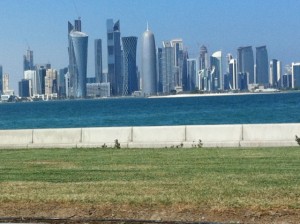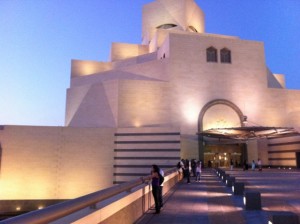Qatar and the World Cup
Posted on December 3rd, 2010 in Uncategorized | 5 Comments »
Having just spent a day in Qatar a few weeks ago, I’m fascinated by FIFA’s decision to let the desert country host the 2022 World Cup there.
It’s an odd choice, even to someone who isn’t a full-time soccer junkie. (Though I am World Cup-obsessed.) You can’t imagine a less likely place to play any outdoor sport than in Qatar. (The North Pole, maybe.) It’s sand and it’s hot—50% Celsius in the summer.
Doha, the capital, is a surreal city, more artificial than Los Angeles or Las Vegas; by all rights, it just shouldn’t exist. But the Qataris have so much oil and natural gas money, they’ve been able to transform the desert into an oasis of brand-name architecture and imported luxury brands. The skyline below (and forgive the pic, which was taken from a moving car) arose within the last decade, mostly the past five years. My wife, Sarah, and I stayed at the Four Seasons; on our way there from the airport we drove past a building under construction whose purpose was to house the Doha branch of the Tribeca Film Festival.
Doha is a city of contradictions. Qatari women are required to bundle up, covering their bodies and, to varying degrees, their faces in black burkas. But at the I.M. Pei-designed Museum of Islamic Art (below), I saw burka-clad girls happily texting on iPhones, and later encountered an older woman accompanied by her husband whose burka was colorful and beautifully woven, a piece of art in itself, and whose hands bore enough diamonds to make Liz Taylor blanch with envy.
Politically, Qatar is an ally of the US. It considers itself a moderate Arabic state and wants to modernize but must tread carefully; according to Wikileaks, it’s been hesitant to act against suspected Al Qaeda figures but agreed to allow the US to use an air base there for a possible strike against Iran. I suppose there’s freedom of speech in Qatar, but probably more in theory than reality, and Google searches on Doha show an odd theme; the results turn up Doha-related websites that all look like they’re funded by the state, but don’t identify themselves as such.
There’s no soccer culture there that I could see; the sport was brought to Qatar by oil workers, and Qatar’s national team has never qualified for the World Cup. A casual impression suggested that the natives (there aren’t very many, and much of Qatar’s workforce, especially the laborers, come from Asia and the Philippines) aren’t very welcoming to outsiders.
Sarah and I were generally ignored as we walked around the Souq Waqif, a marketplace, where you could buy textiles and grains and fig candies and strong coffee made with condensed milk and lots of sugar. (In fact, there wasn’t much that a tourist would want to buy, which is fine, but the market is still fascinating to wander through.) Ignored—but at the same time, we both got a vibe of not being particularly welcomed.
For a western woman in particular, Doha’s a challenge. Female visitors are strongly encouraged to cover all parts of the body from the neck down—no bare arms or calves, for instance—and I suspect that any woman who didn’t take that advice would find herself on the receiving end of some angry glances, if not more.
At the information counter for the Museum of Islamic Art, a Qatari man very politely welcomed me and discussed the museum’s layout. In the several minutes he spoke to me, not once did he talk to, look at or in any way acknowledge Sarah. (Try this in conversation sometime—it can’t be easy.) My impression is that this was a sign of respect; a man doesn’t talk to another man’s wife. But from an American perspective, it’s disconcerting, and for the subject of the experience, not particularly pleasant.
At the same time, however, massive posters along Doha’s main highway showed images of a female tennis star (can’t remember which one); Doha was hosting a USWTA tournament.
So Qatar has ten years to build a bunch of air-conditioned soccer stadiums. I’ve no doubt they can do it. And getting to Qatar won’t be hard; it has a terrific national airline, Qatar Airways, and an airport whose cleanliness, logic and efficiency puts most American ones (especially New York’s) to shame.
What I wonder is whether anyone really wants to go there, either to play or to watch. Some people have wondered whether FIFA’s decision was the result of bribery. Maybe. But corruption or not, it’s also a recognition of a fascinating new geopolitical player.
Below, the Doha skyline, the Museum of Islamic Art, and the Doha waterfront at night.



5 Responses
12/3/2024 12:40 pm
Okay Mr. Stickler (from previous blog “I may be a stickler about such things”)
“older woman accompanied by her husband whose burka was colorful and beautifully woven…”
comma after woman and comma after husband… or was it the husband whose burka was colorful and beautifully woven
12/3/2024 1:07 pm
Fair enough, Sam! Please insert commas before “accompanied” and after “husband.”
12/3/2024 4:32 pm
Could the Qatar choice be based on a strategy by FIFA to reach out to the Middle East, and to host the Cup somewhere in the region that was neutral enough to not upset all other neighbors? Though we present “the Middle East” as one block, nearly all of the countries there are upset with every other one for some reason or another.
12/5/2024 4:45 pm
“50% Celsius in the summer.”
What’s the other 50%? Fahrenheit?
12/6/2024 6:43 am
Sorry, Marcel-just don’t know how to make the degree sign on the keyboard.